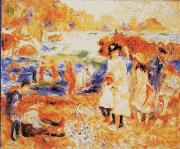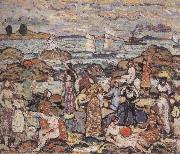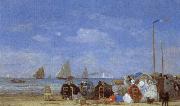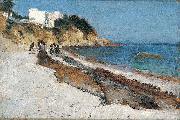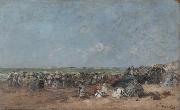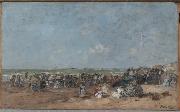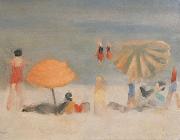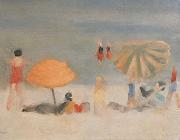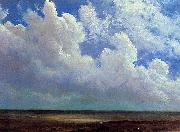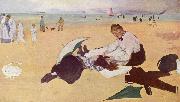Wholesale Oil Painting No Minimum |
|||||||||||
|
|
|||||||||||

|
|||||||||||
|
|
|
||||||||
Pierre RenoirFrench Impressionist Painter, 1841-1919 Pierre-Auguste Renoir (February 25, 1841?CDecember 3, 1919) was a French artist who was a leading painter in the development of the Impressionist style. As a celebrator of beauty, and especially feminine sensuality, it has been said that "Renoir is the final representative of a tradition which runs directly from Rubens to Watteau". Renoir's paintings are notable for their vibrant light and saturated color, most often focusing on people in intimate and candid compositions. The female nude was one of his primary subjects. In characteristic Impressionist style, Renoir suggested the details of a scene through freely brushed touches of color, so that his figures softly fuse with one another and their surroundings. His initial paintings show the influence of the colorism of Eugene Delacroix and the luminosity of Camille Corot. He also admired the realism of Gustave Courbet and Edouard Manet, and his early work resembles theirs in his use of black as a color. As well, Renoir admired Edgar Degas' sense of movement. Another painter Renoir greatly admired was the 18th century master François Boucher. A fine example of Renoir's early work, and evidence of the influence of Courbet's realism, is Diana, 1867. Ostensibly a mythological subject, the painting is a naturalistic studio work, the figure carefully observed, solidly modeled, and superimposed upon a contrived landscape. If the work is still a 'student' piece, already Renoir's heightened personal response to female sensuality is present. The model was Lise Tr??hot, then the artist's mistress and inspiration for a number of paintings. In the late 1860s, through the practice of painting light and water en plein air (in the open air), he and his friend Claude Monet discovered that the color of shadows is not brown or black, but the reflected color of the objects surrounding them. Several pairs of paintings exist in which Renoir and Monet, working side-by-side, depicted the same scenes (La Grenouill??re, 1869). One of the best known Impressionist works is Renoir's 1876 Dance at Le Moulin de la Galette (Le Bal au Moulin de la Galette). The painting depicts an open-air scene, crowded with people, at a popular dance garden on the Butte Montmartre, close to where he lived. On the Terrace, oil on canvas, 1881, Art Institute of ChicagoThe works of his early maturity were typically Impressionist snapshots of real life, full of sparkling colour and light. By the mid 1880s, however, he had broken with the movement to apply a more disciplined, formal technique to portraits and figure paintings, particularly of women, such as The Bathers, which was created during 1884-87. It was a trip to Italy in 1881, when he saw works by Raphael and other Renaissance masters, that convinced him that he was on the wrong path, and for the next several years he painted in a more severe style, in an attempt to return to classicism. This is sometimes called his "Ingres period", as he concentrated on his drawing and emphasized the outlines of figures. After 1890, however, he changed direction again, returning to the use of thinly brushed color which dissolved outlines as in his earlier work. From this period onward he concentrated especially on monumental nudes and domestic scenes, fine examples of which are Girls at the Piano, 1892, and Grandes Baigneuses, 1918-19. The latter painting is the most typical and successful of Renoir's late, abundantly fleshed nudes. A prolific artist, he made several thousand paintings. The warm sensuality of Renoir's style made his paintings some of the most well-known and frequently-reproduced works in the history of art.. |
||||||||
|
|
||||||||
Beach Scene
Beach Scene Painting ID:: 3501 |
|
|||||||
|
|
||||||||
Edgar DegasFrench Realist/Impressionist Painter and Sculptor, 1834-1917 French painter, draughtsman, printmaker, sculptor, pastellist, photographer and collector. He was a founder-member of the Impressionist group and the leader within it of the Realist tendency. He organized several of the group exhibitions, but after 1886 he showed his works very rarely and largely withdrew from the Parisian art world. As he was sufficiently wealthy, he was not constricted by the need to sell his work, and even his late pieces retain a vigour and a power to shock that is lacking in the contemporary productions of his Impressionist colleagues. |
||||||||
|
|
||||||||
|
|
Beach Scene
Beach Scene Painting ID:: 50045 |
mk206
about 1869-70
London,National Gallery
mk206 about 1869-70 London,National Gallery |
||||||
|
|
||||||||
|
|
||||||||
|
|
Beach scene
Beach scene Painting ID:: 50581 |
mk212
c.1910-1913
Oil on canvas
76.2x86.4cm
mk212 c.1910-1913 Oil on canvas 76.2x86.4cm |
||||||
|
|
||||||||
Eugene Boudin1824-1898 French landscape painter. Encouraged at an early age by Jean-Francois Millet, Boudin became a strong advocate of painting directly from nature. In 1874 he exhibited with the Impressionists, but, unlike those painters, he was not an innovator, and from 1863 to 1897 he exhibited regularly in the official Salon. His favourite subjects were beach scenes and seascapes, which show remarkable sensitivity to effects of atmosphere; on the backs of his paintings he recorded the weather, light, and time of day. His works link the careful naturalism of the mid 19th century and the brilliant colours and fluid brushwork of Impressionism. |
||||||||
|
|
||||||||
|
|
Beach Scene
Beach Scene Painting ID:: 54531 |
mk235
1863
Oil on canvas
mk235 1863 Oil on canvas |
||||||
|
|
||||||||
Eugene Boudin1824-1898 French landscape painter. Encouraged at an early age by Jean-Francois Millet, Boudin became a strong advocate of painting directly from nature. In 1874 he exhibited with the Impressionists, but, unlike those painters, he was not an innovator, and from 1863 to 1897 he exhibited regularly in the official Salon. His favourite subjects were beach scenes and seascapes, which show remarkable sensitivity to effects of atmosphere; on the backs of his paintings he recorded the weather, light, and time of day. His works link the careful naturalism of the mid 19th century and the brilliant colours and fluid brushwork of Impressionism. |
||||||||
|
|
||||||||
|
|
Beach Scene
Beach Scene Painting ID:: 54532 |
mk235
1864
Oil oncanvas
mk235 1864 Oil oncanvas |
||||||
|
|
||||||||
Eugene Boudin1824-1898 French landscape painter. Encouraged at an early age by Jean-Francois Millet, Boudin became a strong advocate of painting directly from nature. In 1874 he exhibited with the Impressionists, but, unlike those painters, he was not an innovator, and from 1863 to 1897 he exhibited regularly in the official Salon. His favourite subjects were beach scenes and seascapes, which show remarkable sensitivity to effects of atmosphere; on the backs of his paintings he recorded the weather, light, and time of day. His works link the careful naturalism of the mid 19th century and the brilliant colours and fluid brushwork of Impressionism. |
||||||||
|
|
||||||||
|
|
Beach Scene
Beach Scene Painting ID:: 54533 |
mk235
1863
Oil on canvas
34.9x57.8cm
mk235 1863 Oil on canvas 34.9x57.8cm |
||||||
|
|
||||||||
John Singer Sargent1856-1925 John Singer Sargent Locations John Singer Sargent (January 12, 1856 ?C April 14, 1925) was the most successful portrait painter of his era. During his career, he created roughly 900 oil paintings and more than 2,000 watercolors, as well as countless sketches and charcoal drawings. His oeuvre documents worldwide travel, from Venice to the Tyrol, Corfu, the Middle East, Montana, Maine, and Florida. Before Sargent??s birth, his father FitzWilliam was an eye surgeon at the Wills Hospital in Philadelphia. After his older sister died at the age of two, his mother Mary (n??e Singer) suffered a mental collapse and the couple decided to go abroad to recover. They remained nomadic ex-patriates for the rest of their lives. Though based in Paris, Sargent??s parents moved regularly with the seasons to the sea and the mountain resorts in France, Germany, Italy, and Switzerland. While she was pregnant, they stopped in Florence, Italy because of a cholera epidemic, and there Sargent was born in 1856. A year later, his sister Mary was born. After her birth FitzWilliam reluctantly resigned his post in Philadelphia and accepted his wife??s entreaties to remain abroad. They lived modestly on a small inheritance and savings, living an isolated life with their children and generally avoiding society and other Americans except for friends in the art world. Four more children were born abroad of whom two lived past childhood. Though his father was a patient teacher of basic subjects, young Sargent was a rambunctious child, more interested in outdoor activities than his studies. As his father wrote home, ??He is quite a close observer of animated nature.?? Contrary to his father, his mother was quite convinced that traveling around Europe, visiting museums and churches, would give young Sargent a satisfactory education. Several attempts to give him formal schooling failed, owning mostly to their itinerant life. She was a fine amateur artist and his father was a skilled medical illustrator. Early on, she gave him sketchbooks and encouraged drawing excursions. Young Sargent worked with care on his drawings, and he enthusiastically copied images from the Illustrated London News of ships and made detailed sketches of landscapes. FitzWilliam had hoped that his son??s interest in ships and the sea might lead him toward a naval career. At thirteen, his mother reported that John ??sketches quite nicely, & has a remarkably quick and correct eye. If we could afford to give him really good lessons, he would soon be quite a little artist.?? At age thirteen, he received some watercolor lessons from Carl Welsch, a German landscape painter. Though his education was far from complete, Sargent grew up to be a highly literate and cosmopolitan young man, accomplished in art, music, and literature. He was fluent in French, Italian, and German. At seventeen, Sargent was described as ??willful, curious, determined and strong?? (after his mother) yet shy, generous, and modest (after his father). He was well-acquainted with many of the great masters from first hand observation, as he wrote in 1874, ??I have learned in Venice to admire Tintoretto immensely and to consider him perhaps second only to Michael Angelo and Titian.?? |
||||||||
|
|
||||||||
|
|
Beach Scene
Beach Scene Painting ID:: 68247 |
John Singer Sargent, Beach Scene, 1880. Oil on panel, private collection John Singer Sargent, Beach Scene, 1880. Oil on panel, private collection |
||||||
|
|
||||||||
Eugene Boudin1824-1898 French landscape painter. Encouraged at an early age by Jean-Francois Millet, Boudin became a strong advocate of painting directly from nature. In 1874 he exhibited with the Impressionists, but, unlike those painters, he was not an innovator, and from 1863 to 1897 he exhibited regularly in the official Salon. His favourite subjects were beach scenes and seascapes, which show remarkable sensitivity to effects of atmosphere; on the backs of his paintings he recorded the weather, light, and time of day. His works link the careful naturalism of the mid 19th century and the brilliant colours and fluid brushwork of Impressionism. |
||||||||
|
|
||||||||
|
|
Beach Scene
Beach Scene Painting ID:: 72943 |
"Beach Scene," by Eugene Louis Boudin, oil on canvas. 9 3/8 in. x 14 1/2 in. Yale University Art Gallery, gift of Edward B. Greene, B.A. 1900. Courtesy of Yale University, New Haven, Conn.
cjr "Beach Scene," by Eugene Louis Boudin, oil on canvas. 9 3/8 in. x 14 1/2 in. Yale University Art Gallery, gift of Edward B. Greene, B.A. 1900. Courtesy of Yale University, New Haven, Conn. cjr |
||||||
|
|
||||||||
Eugene Boudin1824-1898 French landscape painter. Encouraged at an early age by Jean-Francois Millet, Boudin became a strong advocate of painting directly from nature. In 1874 he exhibited with the Impressionists, but, unlike those painters, he was not an innovator, and from 1863 to 1897 he exhibited regularly in the official Salon. His favourite subjects were beach scenes and seascapes, which show remarkable sensitivity to effects of atmosphere; on the backs of his paintings he recorded the weather, light, and time of day. His works link the careful naturalism of the mid 19th century and the brilliant colours and fluid brushwork of Impressionism. |
||||||||
|
|
||||||||
|
|
Beach Scene
Beach Scene Painting ID:: 74755 |
English: "Beach Scene," by Eugene Louis Boudin, oil on canvas. 9 3/8 in. x 14 1/2 in. Yale University Art Gallery, gift of Edward B. Greene, B.A. 1900. Courtesy of Yale University, New Haven, Conn.
Date circa 1874-1875
cyf English: "Beach Scene," by Eugene Louis Boudin, oil on canvas. 9 3/8 in. x 14 1/2 in. Yale University Art Gallery, gift of Edward B. Greene, B.A. 1900. Courtesy of Yale University, New Haven, Conn. Date circa 1874-1875 cyf |
||||||
|
|
||||||||
Clarice BeckettAustralian Painter, 1887-1935,Australian painter. She studied at the National Gallery School, Melbourne (1914-16), and with Max Meldrum became involved (c. 1917) with the Meldrum circle of artists, which included Colin Colahan (1897-1987), Justus Jorgensen (1893-1975), John Farmer (b 1897) and Percy Leason (1889-1959). In 1919 she moved to the seaside suburb of Beaumaris, where she lived and worked for the rest of her life. |
||||||||
|
|
||||||||
|
|
Beach Scene
Beach Scene Painting ID:: 79380 |
Beach Scene, painting, oil on canvas, 52.1 x 62.0 cm, by Clarice Beckett
Date 1932(1932)
cjr Beach Scene, painting, oil on canvas, 52.1 x 62.0 cm, by Clarice Beckett Date 1932(1932) cjr |
||||||
|
|
||||||||
Clarice BeckettAustralian Painter, 1887-1935,Australian painter. She studied at the National Gallery School, Melbourne (1914-16), and with Max Meldrum became involved (c. 1917) with the Meldrum circle of artists, which included Colin Colahan (1897-1987), Justus Jorgensen (1893-1975), John Farmer (b 1897) and Percy Leason (1889-1959). In 1919 she moved to the seaside suburb of Beaumaris, where she lived and worked for the rest of her life. |
||||||||
|
|
||||||||
|
|
Beach Scene
Beach Scene Painting ID:: 82325 |
oil on canvas, 52.1 x 62.0 cm, by Clarice Beckett
cyf oil on canvas, 52.1 x 62.0 cm, by Clarice Beckett cyf |
||||||
|
|
||||||||
Albert BierstadtGerman-born American Hudson River School Painter, 1830-1902 Bierstadt was born in Solingen, Germany. His family moved to New Bedford, Massachusetts, in 1833. He studied painting with the members of the D??sseldorf School in D??sseldorf, Germany from 1853 to 1857. He taught drawing and painting briefly before devoting himself to painting. Bierstadt began making paintings in New England and upstate New York. In 1859, he traveled westward in the company of a Land Surveyor for the U.S. government, returning with sketches that would result in numerous finished paintings. In 1863 he returned west again, in the company of the author Fitz Hugh Ludlow, whose wife he would later marry. He continued to visit the American West throughout his career. Though his paintings sold for princely sums, Bierstadt was not held in particularly high esteem by critics of his day. His use of uncommonly large canvases was thought to be an egotistical indulgence, as his paintings would invariably dwarf those of his contemporaries when they were displayed together. The romanticism evident in his choices of subject and in his use of light was felt to be excessive by contemporary critics. His paintings emphasized atmospheric elements like fog, clouds and mist to accentuate and complement the feel of his work. Bierstadt sometimes changed details of the landscape to inspire awe. The colors he used are also not always true. He painted what he believed is the way things should be: water is ultramarine, vegetation is lush and green, etc. The shift from foreground to background was very dramatic and there was almost no middle distance Nonetheless, his paintings remain popular. He was a prolific artist, having completed over 500 (possibly as many as 4000) paintings during his lifetime, most of which have survived. Many are scattered through museums around the United States. Prints are available commercially for many. Original paintings themselves do occasionally come up for sale, at ever increasing prices. |
||||||||
|
|
||||||||
|
|
Beach Scene
Beach Scene Painting ID:: 95848 |
Date 1872(1872)
Dimensions 19.25 x 24.25 in (48.9 x 61.6 cm)
ttd Date 1872(1872) Dimensions 19.25 x 24.25 in (48.9 x 61.6 cm) ttd |
||||||
|
|
||||||||
Edgar DegasFrench Realist/Impressionist Painter and Sculptor, 1834-1917 French painter, draughtsman, printmaker, sculptor, pastellist, photographer and collector. He was a founder-member of the Impressionist group and the leader within it of the Realist tendency. He organized several of the group exhibitions, but after 1886 he showed his works very rarely and largely withdrew from the Parisian art world. As he was sufficiently wealthy, he was not constricted by the need to sell his work, and even his late pieces retain a vigour and a power to shock that is lacking in the contemporary productions of his Impressionist colleagues. |
||||||||
|
|
||||||||
|
|
Beach Scene
Beach Scene Painting ID:: 97070 |
1876-1877
Medium oil on paper mounted on canvas
Dimensions 47 X 82.6 cm (18.5 X 32.5 in)
cyf 1876-1877 Medium oil on paper mounted on canvas Dimensions 47 X 82.6 cm (18.5 X 32.5 in) cyf |
||||||
|
|
||||||||
|
Edgar Degas French Realist/Impressionist Painter and Sculptor, 1834-1917 French painter, draughtsman, printmaker, sculptor, pastellist, photographer and collector. He was a founder-member of the Impressionist group and the leader within it of the Realist tendency. He organized several of the group exhibitions, but after 1886 he showed his works very rarely and largely withdrew from the Parisian art world. As he was sufficiently wealthy, he was not constricted by the need to sell his work, and even his late pieces retain a vigour and a power to shock that is lacking in the contemporary productions of his Impressionist colleagues. Beach Scene 1876-1877 Medium oil on paper mounted on canvas Dimensions 47 X 82.6 cm (18.5 X 32.5 in) cyf |
||||||||
|
|
||||||||
|
Prev Next
|
||||||||
|
|
||||||||
|
Related Paintings to Edgar Degas :. |
||||||||
|
|
||||||||
|
CONTACT US |
